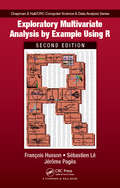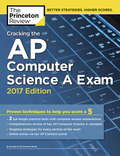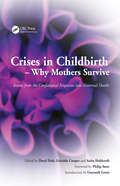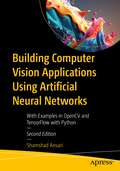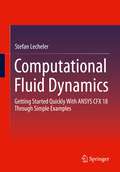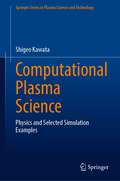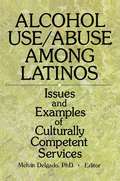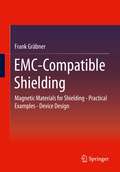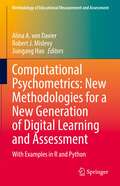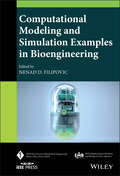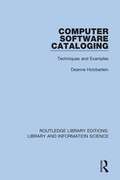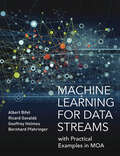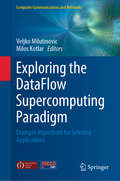Special Collections
Competitive Exam
- Table View
- List View
Bihari Ratnakar Competetive Exam
by Sri Jagannath Das Ratnakar"Bihari-Ratnakar" - It was a few days that it was produced and is going to be published soon. The commentary is very short, but the meaning of about twenty-five couplets is very unique and the lessons of the couplets have been very pure as far as possible. Its author is a famous poet of Kashi at this time. His real name is Babu Jagannathdas.
Exploratory Multivariate Analysis by Example Using R
by Jérôme Pagès and Sebastien Le and Francois HussonFull of real-world case studies and practical advice, Exploratory Multivariate Analysis by Example Using R, Second Edition focuses on four fundamental methods of multivariate exploratory data analysis that are most suitable for applications. It covers principal component analysis (PCA) when variables are quantitative, correspondence analysis (CA) a
Exploratory Multivariate Analysis by Example Using R
by Jérôme Pagès and Sebastien Le and Francois HussonFull of real-world case studies and practical advice, Exploratory Multivariate Analysis by Example Using R, Second Edition focuses on four fundamental methods of multivariate exploratory data analysis that are most suitable for applications. It covers principal component analysis (PCA) when variables are quantitative, correspondence analysis (CA) a
Cracking the AP Computer Science A Exam, 2017 Edition
by Princeton ReviewThis eBook edition has been specially formatted for on-screen viewing with cross-linked questions, answers, and explanations.EVERYTHING YOU NEED TO HELP SCORE A PERFECT 5. Equip yourself to ace the AP Computer Science A Exam with The Princeton Review's brand-new, comprehensive study guide--including 2 full-length practice tests, thorough content reviews, access to our AP Connect online portal, and targeted strategies for every section of the exam.This brand new addition to our best-selling Cracking the AP Exam series is perfect for students tackling the fast-growing AP Computer Science A test. Easy to understand and simple to use, this book gives you all the tools you need to get the score you want.Everything You Need to Know to Help Achieve a High Score.* Comprehensive content review of key Computer Science A topics, including lab requirements* Up-to-date information on the 2017 AP Computer Science A Exam* Engaging activities to help you critically assess your progress* Access to AP Connect, our online portal for helpful pre-college information and exam updatesPractice Your Way to Excellence.* 2 full-length practice tests with detailed answer explanations* Comprehension drills in each content review chapter* Step-by-step walk-throughs of sample questionsTechniques That Actually Work.* Tried-and-true strategies to help you avoid traps and beat the test* Tips for pacing yourself and guessing logically* Essential tactics to help you work smarter, not harder
Crises in Childbirth - Why Mothers Survive
by Griselda Cooper and Daryl Dob and Anita HoldcroftThis work includes Foreword by Phillip J S Steer, Professor of Obstetrics, Faculty of Medicine, Imperial College London. It includes Introduction by Gwyneth Lewis, National Clinical Lead for Maternal Health and Maternity Services, Department of Health, England and Director of the UK Confidential Enquiries into Maternal Deaths. 'The reductions in maternal mortality over the last half century are an eloquent testimony to the value of the technical expertise in life support that anaesthetists bring to the management of labour complications. Many direct causes of maternal death have been substantially reduced as a result of anaesthetic innovations ranging from advances in regional anaesthesia to the panoply of techniques used in intensive care. This book is essential reading.' - Phillip J Steer, in his Foreword. Offering a unique insight into real cases, this book covers the physiology, pharmacology and organisational factors involved in previous maternal deaths, highlighting key lessons to be learnt. This practical guide provides an ideal introduction for new anaesthetists and up-to-date information for senior practitioners, particularly those who cover labour wards. It is also invaluable for anaesthetic nurses, obstetricians and midwives. 'For more than 50 years the Confidential Enquiries into Maternal Deaths in the UK have collected together invaluable information about why mothers die in pregnancy and childbirth. For the first time ever, this unique book collects together all the valuable lessons into one volume. Experts in their fields provide a physiological, pharmacological, and evidence based commentary on the events of each death. The overall result pays homage to the value of collecting together lessons from the past, and we hope will help people avoid repetition of these situations in the future.' - Daryl Dob, Anita Holdcroft and Griselda Cooper, in the Preface.
Crises in Childbirth - Why Mothers Survive
by Griselda Cooper and Daryl Dob and Anita HoldcroftThis work includes Foreword by Phillip J S Steer, Professor of Obstetrics, Faculty of Medicine, Imperial College London. It includes Introduction by Gwyneth Lewis, National Clinical Lead for Maternal Health and Maternity Services, Department of Health, England and Director of the UK Confidential Enquiries into Maternal Deaths. 'The reductions in maternal mortality over the last half century are an eloquent testimony to the value of the technical expertise in life support that anaesthetists bring to the management of labour complications. Many direct causes of maternal death have been substantially reduced as a result of anaesthetic innovations ranging from advances in regional anaesthesia to the panoply of techniques used in intensive care. This book is essential reading.' - Phillip J Steer, in his Foreword. Offering a unique insight into real cases, this book covers the physiology, pharmacology and organisational factors involved in previous maternal deaths, highlighting key lessons to be learnt. This practical guide provides an ideal introduction for new anaesthetists and up-to-date information for senior practitioners, particularly those who cover labour wards. It is also invaluable for anaesthetic nurses, obstetricians and midwives. 'For more than 50 years the Confidential Enquiries into Maternal Deaths in the UK have collected together invaluable information about why mothers die in pregnancy and childbirth. For the first time ever, this unique book collects together all the valuable lessons into one volume. Experts in their fields provide a physiological, pharmacological, and evidence based commentary on the events of each death. The overall result pays homage to the value of collecting together lessons from the past, and we hope will help people avoid repetition of these situations in the future.' - Daryl Dob, Anita Holdcroft and Griselda Cooper, in the Preface.
Building Computer Vision Applications Using Artificial Neural Networks
by Shamshad AnsariComputer vision is constantly evolving, and this book has been updated to reflect new topics that have emerged in the field since the first edition’s publication. All code used in the book has also been fully updated. This second edition features new material covering image manipulation practices, image segmentation, feature extraction, and object identification using real-life scenarios to help reinforce each concept. These topics are essential for building advanced computer vision applications, and you’ll gain a thorough understanding of them. The book’s source code has been updated from TensorFlow 1.x to 2.x, and includes step-by-step examples using both OpenCV and TensorFlow with Python. Upon completing this book, you’ll have the knowledge and skills to build your own computer vision applications using neural networks What You Will Learn Understand image processing, manipulation techniques, and feature extraction methodsWork with convolutional neural networks (CNN), single-shot detector (SSD), and YOLOUtilize large scale model development and cloud infrastructure deploymentGain an overview of FaceNet neural network architecture and develop a facial recognition system Who This Book Is For Those who possess a solid understanding of Python programming and wish to gain an understanding of computer vision and machine learning. It will prove beneficial to data scientists, deep learning experts, and students.
Building Computer Vision Applications Using Artificial Neural Networks
by Shamshad AnsariComputer vision is constantly evolving, and this book has been updated to reflect new topics that have emerged in the field since the first edition’s publication. All code used in the book has also been fully updated. This second edition features new material covering image manipulation practices, image segmentation, feature extraction, and object identification using real-life scenarios to help reinforce each concept. These topics are essential for building advanced computer vision applications, and you’ll gain a thorough understanding of them. The book’s source code has been updated from TensorFlow 1.x to 2.x, and includes step-by-step examples using both OpenCV and TensorFlow with Python. Upon completing this book, you’ll have the knowledge and skills to build your own computer vision applications using neural networks What You Will Learn Understand image processing, manipulation techniques, and feature extraction methodsWork with convolutional neural networks (CNN), single-shot detector (SSD), and YOLOUtilize large scale model development and cloud infrastructure deploymentGain an overview of FaceNet neural network architecture and develop a facial recognition system Who This Book Is For Those who possess a solid understanding of Python programming and wish to gain an understanding of computer vision and machine learning. It will prove beneficial to data scientists, deep learning experts, and students.
Computational Fluid Dynamics
by Stefan LechelerThis textbook and exercise book is aimed at future users of computational fluid dynamics software. In addition to the comprehensibly presented basics, the focus is on technical examples treated in detail with supplementary practical hints. Comprehension questions including applications give the beginner confidence in fundamental relationships. The original 4th German edition has been adapted to the latest program version ANSYS 18.1.
Computational Fluid Dynamics
by Stefan LechelerThis textbook and exercise book is aimed at future users of computational fluid dynamics software. In addition to the comprehensibly presented basics, the focus is on technical examples treated in detail with supplementary practical hints. Comprehension questions including applications give the beginner confidence in fundamental relationships. The original 4th German edition has been adapted to the latest program version ANSYS 18.1.
Computational Plasma Science
by Shigeo KawataThe book presents fundamentals of plasma physics with rich references and computational techniques in a concise manner. It particularly focuses on introductions to numerical simulation methods in plasma physics, in addition to those to physics and mathematics in plasma physics. It also presents the fundamentals of numerical methods, which solve mathematical models of plasmas, together with examples of numerical results. A discretization method, the so-called finite difference method, is introduced for particle-in-cell methods and fluid codes, which have been widely employed in plasma physics studies. In addition to the introduction to numerical solutions, it also covers numerical stability. The instabilities and numerical errors significantly influence the results, and for correct results, great efforts are required to avoid such numerical artifacts. The book also carefully discusses the numerical errors, numerical stability, and uncertainty in numerical computations. Readers are expected to have an understanding of fundamental physics of mechanics, electromagnetism, thermodynamics, statistical physics, relativity, fluid dynamics, and mathematics, but the book does not assume background knowledge on plasma. Therefore, it is a first book of plasma physics for upper undergraduate and early graduate students who are interested in learning it.
Computational Plasma Science
by Shigeo KawataThe book presents fundamentals of plasma physics with rich references and computational techniques in a concise manner. It particularly focuses on introductions to numerical simulation methods in plasma physics, in addition to those to physics and mathematics in plasma physics. It also presents the fundamentals of numerical methods, which solve mathematical models of plasmas, together with examples of numerical results. A discretization method, the so-called finite difference method, is introduced for particle-in-cell methods and fluid codes, which have been widely employed in plasma physics studies. In addition to the introduction to numerical solutions, it also covers numerical stability. The instabilities and numerical errors significantly influence the results, and for correct results, great efforts are required to avoid such numerical artifacts. The book also carefully discusses the numerical errors, numerical stability, and uncertainty in numerical computations. Readers are expected to have an understanding of fundamental physics of mechanics, electromagnetism, thermodynamics, statistical physics, relativity, fluid dynamics, and mathematics, but the book does not assume background knowledge on plasma. Therefore, it is a first book of plasma physics for upper undergraduate and early graduate students who are interested in learning it.
Alcohol Use/Abuse Among Latinos
by Melvin DelgadoIn Alcohol Use/Abuse Among Latinos: Issues and Examples of Culturally Competent Services, you will learn how to design and improve services for Latinos with substance abuse problems by understanding that the cultures and personal backgrounds of your clients are crucial to the counseling process. This text will also show you how these service skills apply to the individual, family, or an entire community. Studies show that, according to patients, culturally sensitive and responsive practitioners are generally more credible, trusted, and effective. Alcohol Use/Abuse Among Latinos takes into account several different aspects that will help you develop these traits and provide successful services for Latinos dealing with alcohol or other drug problems. You&’ll gain valuable insight into:the five elements that are vital to a successful ATOD (Alcohol, tobacco and Other Drug) service--multiculturism, resilience/strengths, competence, community capacity development, and community participation--plus a detailed explanation of why they are needed step-by-step instructions for using three methods, supervision, inservice training, and consultation, as means of providing ongoing learning of cross-cultural competencies to practitioners why key factors such as economic background, gender, and sexual orientation need to be taken into consideration for ATOD services to be effective demographic patterns and case studies of Latino users and abusers of alcohol and other drugs that illustrate the growing number of Latinos in need of ATOD services why the practitioner needs to be aware of how family importance, values attached to cooperation versus competition, sociability, respect, and action-oriented problem-solving play a role in effective services for Latinos the need for practitioners to understand how ethnic identity, biculturality, Spanish language fluency, gender-specific role expectations, skin color, and overall sense of self can affect the success of services for Latino teenagers how excessive marketing of alcohol to Latino communities, lack of representation, and a lack of community involvement are key barriers to successful ATOD services for LatinosAlcohol Use/Abuse Among Latinos also discusses Latino mens’and womens’individual needs concerning substance abuse. One of the topics addressed, the loss of self-esteem, has been found to be a contributing factor to alcohol use and abuse for Latinas. It offers ways you can promote self-esteem in your Latina clients by focusing on their cultural heritage and pride. In addition, this text takes a unique look Latina lesbians and how training through educational and agency internship programs can promote awareness to your clients&’ special needs concerning substance abuse. Alcohol Use/Abuse Among Latinos will help you provide all of your Latino clients with efficient and culture-friendly services for resisting or overcoming the abuse of alcohol, tobacco, or other drugs.
Alcohol Use/Abuse Among Latinos
by Melvin DelgadoIn Alcohol Use/Abuse Among Latinos: Issues and Examples of Culturally Competent Services, you will learn how to design and improve services for Latinos with substance abuse problems by understanding that the cultures and personal backgrounds of your clients are crucial to the counseling process. This text will also show you how these service skills apply to the individual, family, or an entire community. Studies show that, according to patients, culturally sensitive and responsive practitioners are generally more credible, trusted, and effective. Alcohol Use/Abuse Among Latinos takes into account several different aspects that will help you develop these traits and provide successful services for Latinos dealing with alcohol or other drug problems. You&’ll gain valuable insight into:the five elements that are vital to a successful ATOD (Alcohol, tobacco and Other Drug) service--multiculturism, resilience/strengths, competence, community capacity development, and community participation--plus a detailed explanation of why they are needed step-by-step instructions for using three methods, supervision, inservice training, and consultation, as means of providing ongoing learning of cross-cultural competencies to practitioners why key factors such as economic background, gender, and sexual orientation need to be taken into consideration for ATOD services to be effective demographic patterns and case studies of Latino users and abusers of alcohol and other drugs that illustrate the growing number of Latinos in need of ATOD services why the practitioner needs to be aware of how family importance, values attached to cooperation versus competition, sociability, respect, and action-oriented problem-solving play a role in effective services for Latinos the need for practitioners to understand how ethnic identity, biculturality, Spanish language fluency, gender-specific role expectations, skin color, and overall sense of self can affect the success of services for Latino teenagers how excessive marketing of alcohol to Latino communities, lack of representation, and a lack of community involvement are key barriers to successful ATOD services for LatinosAlcohol Use/Abuse Among Latinos also discusses Latino mens’and womens’individual needs concerning substance abuse. One of the topics addressed, the loss of self-esteem, has been found to be a contributing factor to alcohol use and abuse for Latinas. It offers ways you can promote self-esteem in your Latina clients by focusing on their cultural heritage and pride. In addition, this text takes a unique look Latina lesbians and how training through educational and agency internship programs can promote awareness to your clients&’ special needs concerning substance abuse. Alcohol Use/Abuse Among Latinos will help you provide all of your Latino clients with efficient and culture-friendly services for resisting or overcoming the abuse of alcohol, tobacco, or other drugs.
EMC-Compatible Shielding
by Frank GräbnerThe 3rd edition was extended by the chapter "Novel Future Ferrites - Hexagonal Ferrites". The reader is thus given the basics of the various shielding effects in a compressed form. This book is addressed to engineers, scientists, students, researchers and specialists from the practice. Shielding for ensuring EMC in high-frequency and radar technology has been developing with ever increasing dynamics since about 1960. The understanding of the interaction of a magnetic material and the resulting phenomenon of shielding is illustrated by simple examples and practical applications.
EMC-Compatible Shielding
by Frank GräbnerThe 3rd edition was extended by the chapter "Novel Future Ferrites - Hexagonal Ferrites". The reader is thus given the basics of the various shielding effects in a compressed form. This book is addressed to engineers, scientists, students, researchers and specialists from the practice. Shielding for ensuring EMC in high-frequency and radar technology has been developing with ever increasing dynamics since about 1960. The understanding of the interaction of a magnetic material and the resulting phenomenon of shielding is illustrated by simple examples and practical applications.
Computational Psychometrics
by Robert J. Mislevy and Alina A. von Davier and Jiangang HaoThis book defines and describes a new discipline, named “computational psychometrics,” from the perspective of new methodologies for handling complex data from digital learning and assessment. The editors and the contributing authors discuss how new technology drastically increases the possibilities for the design and administration of learning and assessment systems, and how doing so significantly increases the variety, velocity, and volume of the resulting data. Then they introduce methods and strategies to address the new challenges, ranging from evidence identification and data modeling to the assessment and prediction of learners’ performance in complex settings, as in collaborative tasks, game/simulation-based tasks, and multimodal learning and assessment tasks.Computational psychometrics has thus been defined as a blend of theory-based psychometrics and data-driven approaches from machine learning, artificial intelligence, and data science. All these together provide a better methodological framework for analysing complex data from digital learning and assessments. The term “computational” has been widely adopted by many other areas, as with computational statistics, computational linguistics, and computational economics. In those contexts, “computational” has a meaning similar to the one proposed in this book: a data-driven and algorithm-focused perspective on foundations and theoretical approaches established previously, now extended and, when necessary, reconceived. This interdisciplinarity is already a proven success in many disciplines, from personalized medicine that uses computational statistics to personalized learning that uses, well, computational psychometrics. We expect that this volume will be of interest not just within but beyond the psychometric community.In this volume, experts in psychometrics, machine learning, artificial intelligence, data science and natural language processing illustrate their work, showing how the interdisciplinary expertise of each researcher blends into a coherent methodological framework to deal with complex data from complex virtual interfaces. In the chapters focusing on methodologies, the authors use real data examples to demonstrate how to implement the new methods in practice. The corresponding programming codes in R and Python have been included as snippets in the book and are also available in fuller form in the GitHub code repository that accompanies the book.
Computational Psychometrics
by Robert J. Mislevy and Alina A. von Davier and Jiangang HaoThis book defines and describes a new discipline, named “computational psychometrics,” from the perspective of new methodologies for handling complex data from digital learning and assessment. The editors and the contributing authors discuss how new technology drastically increases the possibilities for the design and administration of learning and assessment systems, and how doing so significantly increases the variety, velocity, and volume of the resulting data. Then they introduce methods and strategies to address the new challenges, ranging from evidence identification and data modeling to the assessment and prediction of learners’ performance in complex settings, as in collaborative tasks, game/simulation-based tasks, and multimodal learning and assessment tasks.Computational psychometrics has thus been defined as a blend of theory-based psychometrics and data-driven approaches from machine learning, artificial intelligence, and data science. All these together provide a better methodological framework for analysing complex data from digital learning and assessments. The term “computational” has been widely adopted by many other areas, as with computational statistics, computational linguistics, and computational economics. In those contexts, “computational” has a meaning similar to the one proposed in this book: a data-driven and algorithm-focused perspective on foundations and theoretical approaches established previously, now extended and, when necessary, reconceived. This interdisciplinarity is already a proven success in many disciplines, from personalized medicine that uses computational statistics to personalized learning that uses, well, computational psychometrics. We expect that this volume will be of interest not just within but beyond the psychometric community.In this volume, experts in psychometrics, machine learning, artificial intelligence, data science and natural language processing illustrate their work, showing how the interdisciplinary expertise of each researcher blends into a coherent methodological framework to deal with complex data from complex virtual interfaces. In the chapters focusing on methodologies, the authors use real data examples to demonstrate how to implement the new methods in practice. The corresponding programming codes in R and Python have been included as snippets in the book and are also available in fuller form in the GitHub code repository that accompanies the book.
Computational Modeling and Simulation Examples in Bioengineering
by Nenad D. FilipovicA systematic overview of the quickly developing field of bioengineering—with state-of-the-art modeling software! Computational Modeling and Simulation Examples in Bioengineering provides a comprehensive introduction to the emerging field of bioengineering. It provides the theoretical background necessary to simulating pathological conditions in the bones, muscles, cardiovascular tissue, and cancers, as well as lung and vertigo disease. The methodological approaches used for simulations include the finite element, dissipative particle dynamics, and lattice Boltzman. The text includes access to a state-of-the-art software package for simulating the theoretical problems. In this way, the book enhances the reader's learning capabilities in the field of biomedical engineering. The aim of this book is to provide concrete examples of applied modeling in biomedical engineering. Examples in a wide range of areas equip the reader with a foundation of knowledge regarding which problems can be modeled with which numerical methods. With more practical examples and more online software support than any competing text, this book organizes the field of computational bioengineering into an accessible and thorough introduction. Computational Modeling and Simulation Examples in Bioengineering: Includes a state-of-the-art software package enabling readers to engage in hands-on modeling of the examples in the book Provides a background on continuum and discrete modeling, along with equations and derivations for three key numerical methods Considers examples in the modeling of bones, skeletal muscles, cartilage, tissue engineering, blood flow, plaque, and more Explores stent deployment modeling as well as stent design and optimization techniques Generates different examples of fracture fixation with respect to the advantages in medical practice applications Computational Modeling and Simulation Examples in Bioengineering is an excellent textbook for students of bioengineering, as well as a support for basic and clinical research. Medical doctors and other clinical professionals will also benefit from this resource and guide to the latest modeling techniques.
Computational Modeling and Simulation Examples in Bioengineering
by Nenad D. FilipovicA systematic overview of the quickly developing field of bioengineering—with state-of-the-art modeling software! Computational Modeling and Simulation Examples in Bioengineering provides a comprehensive introduction to the emerging field of bioengineering. It provides the theoretical background necessary to simulating pathological conditions in the bones, muscles, cardiovascular tissue, and cancers, as well as lung and vertigo disease. The methodological approaches used for simulations include the finite element, dissipative particle dynamics, and lattice Boltzman. The text includes access to a state-of-the-art software package for simulating the theoretical problems. In this way, the book enhances the reader's learning capabilities in the field of biomedical engineering. The aim of this book is to provide concrete examples of applied modeling in biomedical engineering. Examples in a wide range of areas equip the reader with a foundation of knowledge regarding which problems can be modeled with which numerical methods. With more practical examples and more online software support than any competing text, this book organizes the field of computational bioengineering into an accessible and thorough introduction. Computational Modeling and Simulation Examples in Bioengineering: Includes a state-of-the-art software package enabling readers to engage in hands-on modeling of the examples in the book Provides a background on continuum and discrete modeling, along with equations and derivations for three key numerical methods Considers examples in the modeling of bones, skeletal muscles, cartilage, tissue engineering, blood flow, plaque, and more Explores stent deployment modeling as well as stent design and optimization techniques Generates different examples of fracture fixation with respect to the advantages in medical practice applications Computational Modeling and Simulation Examples in Bioengineering is an excellent textbook for students of bioengineering, as well as a support for basic and clinical research. Medical doctors and other clinical professionals will also benefit from this resource and guide to the latest modeling techniques.
Computer Software Cataloging
by Deanne HolzberleinThis book, first published in 1985, examines the professional librarians’ needs for cataloging computer software. Examples of software labels, title screens, and catalog cards are used to illustrate how to catalog microcomputer software according to the 1974 Guidelines to Chapter 9 of the Anglo-American Cataloging Rules, 2nd edition. The samples include educational programs, educational games, and business and public disks and cassettes.
Machine Learning for Data Streams
by Bernhard Pfahringer and Albert Bifet and Ricard Gavalda and Geoff HolmesA hands-on approach to tasks and techniques in data stream mining and real-time analytics, with examples in MOA, a popular freely available open-source software framework. Today many information sources—including sensor networks, financial markets, social networks, and healthcare monitoring—are so-called data streams, arriving sequentially and at high speed. Analysis must take place in real time, with partial data and without the capacity to store the entire data set. This book presents algorithms and techniques used in data stream mining and real-time analytics. Taking a hands-on approach, the book demonstrates the techniques using MOA (Massive Online Analysis), a popular, freely available open-source software framework, allowing readers to try out the techniques after reading the explanations. The book first offers a brief introduction to the topic, covering big data mining, basic methodologies for mining data streams, and a simple example of MOA. More detailed discussions follow, with chapters on sketching techniques, change, classification, ensemble methods, regression, clustering, and frequent pattern mining. Most of these chapters include exercises, an MOA-based lab session, or both. Finally, the book discusses the MOA software, covering the MOA graphical user interface, the command line, use of its API, and the development of new methods within MOA. The book will be an essential reference for readers who want to use data stream mining as a tool, researchers in innovation or data stream mining, and programmers who want to create new algorithms for MOA.
Multiple-Choice and Free-Response Questions in Preparation for the AP Computer Science Examination
by Leon SchramThe review concludes with a set of tricky questions, also known as snooker questions. A snooker question is a question that a student with good knowledge of a topic, nevertheless gets wrong. Therefore, we have devoted a large chapter for snooker questions. This new chapter covers 15 major topic areas that are tested on the AP Exam and provides two questions for each topic, to assist students with subtle trickiness in questions.
Exploring the DataFlow Supercomputing Paradigm
by Veljko Milutinovic and Milos KotlarThis useful text/reference describes the implementation of a varied selection of algorithms in the DataFlow paradigm, highlighting the exciting potential of DataFlow computing for applications in such areas as image understanding, biomedicine, physics simulation, and business.The mapping of additional algorithms onto the DataFlow architecture is also covered in the following Springer titles from the same team: DataFlow Supercomputing Essentials: Research, Development and Education, DataFlow Supercomputing Essentials: Algorithms, Applications and Implementations, and Guide to DataFlow Supercomputing.Topics and Features: introduces a novel method of graph partitioning for large graphs involving the construction of a skeleton graph; describes a cloud-supported web-based integrated development environment that can develop and run programs without DataFlow hardware owned by the user; showcases a new approach for the calculation of the extrema of functions in one dimension, by implementing the Golden Section Search algorithm; reviews algorithms for a DataFlow architecture that uses matrices and vectors as the underlying data structure; presents an algorithm for spherical code design, based on the variable repulsion force method; discusses the implementation of a face recognition application, using the DataFlow paradigm; proposes a method for region of interest-based image segmentation of mammogram images on high-performance reconfigurable DataFlow computers; surveys a diverse range of DataFlow applications in physics simulations, and investigates a DataFlow implementation of a Bitcoin mining algorithm.This unique volume will prove a valuable reference for researchers and programmers of DataFlow computing, and supercomputing in general. Graduate and advanced undergraduate students will also find that the book serves as an ideal supplementary text for courses on Data Mining, Microprocessor Systems, and VLSI Systems.
Exploring the DataFlow Supercomputing Paradigm
by Veljko Milutinovic and Milos KotlarThis useful text/reference describes the implementation of a varied selection of algorithms in the DataFlow paradigm, highlighting the exciting potential of DataFlow computing for applications in such areas as image understanding, biomedicine, physics simulation, and business. The mapping of additional algorithms onto the DataFlow architecture is also covered in the following Springer titles from the same team: DataFlow Supercomputing Essentials: Research, Development and Education, DataFlow Supercomputing Essentials: Algorithms, Applications and Implementations, and Guide to DataFlow Supercomputing. Topics and Features: introduces a novel method of graph partitioning for large graphs involving the construction of a skeleton graph; describes a cloud-supported web-based integrated development environment that can develop and run programs without DataFlow hardware owned by the user; showcases a new approach for the calculation of the extrema of functions in one dimension, by implementing the Golden Section Search algorithm; reviews algorithms for a DataFlow architecture that uses matrices and vectors as the underlying data structure; presents an algorithm for spherical code design, based on the variable repulsion force method; discusses the implementation of a face recognition application, using the DataFlow paradigm; proposes a method for region of interest-based image segmentation of mammogram images on high-performance reconfigurable DataFlow computers; surveys a diverse range of DataFlow applications in physics simulations, and investigates a DataFlow implementation of a Bitcoin mining algorithm. This unique volume will prove a valuable reference for researchers and programmers of DataFlow computing, and supercomputing in general. Graduate and advanced undergraduate students will also find that the book serves as an ideal supplementary text for courses on Data Mining, Microprocessor Systems, and VLSI Systems.

